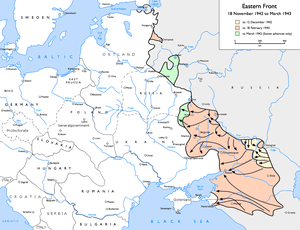Operation Saturn
| Operation Little Saturn | |||||||
|---|---|---|---|---|---|---|---|
| Part of the Battle of Stalingrad during the Eastern Front | |||||||
 Soviet advances during Operations Uranus, Mars and Saturn. |
|||||||
|
|||||||
| Belligerents | |||||||
|
|
|
||||||
| Commanders and leaders | |||||||
|
|
|
||||||
Operation Saturn, revised as Operation Little Saturn, was a Red Army operation on the Eastern Front of World War II that led to battles in the northern Caucasus and Donets Basin regions of the Soviet Union from December 1942 to February 1943.
The success of Operation Uranus, launched on 19 November 1942, had trapped 250,000–300,000 troops of General Friedrich Paulus' German 6th Army and 4th Panzer Army in Stalingrad. To exploit this victory, the Soviet general staff planned a winter campaign of continuous and highly ambitious offensive operations, codenamed "Saturn". Later Joseph Stalin reduced his ambitious plans to a relatively small campaign codenamed "Operation Little Saturn". The offensive succeeded in smashing Germany's Italian and Hungarian allies, applied pressure on the over stretched German forces in Eastern Ukraine and preventing further German advances to the relief of the entrapped forces at Stalingrad. Despite these victories, the Soviets themselves became over extended, setting up the stages for the German offensives of the Third Battle of Kharkov and the Battle of Kursk.
On 17 May 1942, German Army Groups A and B launched a counteroffensive against advancing Soviet armies around the city of Kharkov, resulting in the Second Battle of Kharkov; this would ultimately be expanded on 28 June into Case Blue, which aimed the capture of the Caucasus oil fields. By 6 July, General Hermann Hoth's Fourth Panzer Army had taken the city of Voronezh, threatening to collapse the Red Army's resistance. By early August, General Paul Ludwig Ewald von Kleist's First Panzer Army had reached the oil center of Maykop, 500 kilometres (310 mi) south of the city of Rostov, which had been taken by the Fourth Panzer Army on 23 July. The rapid German advance threatened to cut the Soviet Union off from its southern territories, while also threatening to cut the lend-lease supply lines from Persia. However, the offensive began to peter out, as the offensive's supply train struggled to keep up with the advance and spearhead units began to run low on fuel and manpower; for example, some panzer divisions were down to 54 tanks.
...
Wikipedia
